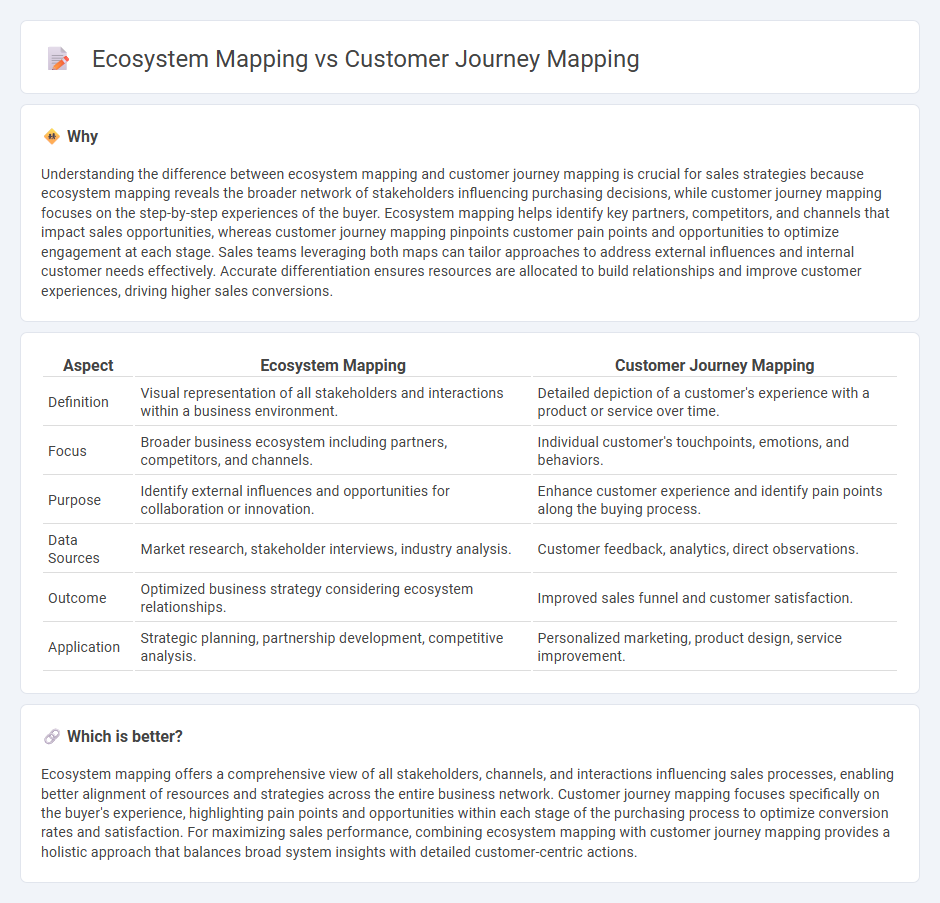
Sales ecosystem mapping illustrates the complex network of stakeholders, channels, and touchpoints influencing buyer behavior, enabling businesses to identify leverage points and optimize partnerships. Customer journey mapping focuses on the step-by-step experiences and emotions customers undergo during their interaction with a brand, highlighting pain points and opportunities to enhance satisfaction. Explore how integrating both approaches unlocks deeper insights and drives more effective sales strategies.
Why it is important
Understanding the difference between ecosystem mapping and customer journey mapping is crucial for sales strategies because ecosystem mapping reveals the broader network of stakeholders influencing purchasing decisions, while customer journey mapping focuses on the step-by-step experiences of the buyer. Ecosystem mapping helps identify key partners, competitors, and channels that impact sales opportunities, whereas customer journey mapping pinpoints customer pain points and opportunities to optimize engagement at each stage. Sales teams leveraging both maps can tailor approaches to address external influences and internal customer needs effectively. Accurate differentiation ensures resources are allocated to build relationships and improve customer experiences, driving higher sales conversions.
Comparison Table
| Aspect | Ecosystem Mapping | Customer Journey Mapping |
|---|---|---|
| Definition | Visual representation of all stakeholders and interactions within a business environment. | Detailed depiction of a customer's experience with a product or service over time. |
| Focus | Broader business ecosystem including partners, competitors, and channels. | Individual customer's touchpoints, emotions, and behaviors. |
| Purpose | Identify external influences and opportunities for collaboration or innovation. | Enhance customer experience and identify pain points along the buying process. |
| Data Sources | Market research, stakeholder interviews, industry analysis. | Customer feedback, analytics, direct observations. |
| Outcome | Optimized business strategy considering ecosystem relationships. | Improved sales funnel and customer satisfaction. |
| Application | Strategic planning, partnership development, competitive analysis. | Personalized marketing, product design, service improvement. |
Which is better?
Ecosystem mapping offers a comprehensive view of all stakeholders, channels, and interactions influencing sales processes, enabling better alignment of resources and strategies across the entire business network. Customer journey mapping focuses specifically on the buyer's experience, highlighting pain points and opportunities within each stage of the purchasing process to optimize conversion rates and satisfaction. For maximizing sales performance, combining ecosystem mapping with customer journey mapping provides a holistic approach that balances broad system insights with detailed customer-centric actions.
Connection
Ecosystem mapping and customer journey mapping intersect by providing a comprehensive view of how customers interact with multiple touchpoints within a sales environment. Ecosystem mapping identifies all stakeholders, platforms, and channels influencing customer behavior, while customer journey mapping details the step-by-step experience of the buyer through these touchpoints. Integrating both maps enhances sales strategies by pinpointing pain points and opportunities across the entire digital and physical sales ecosystem.
Key Terms
**Customer Journey Mapping:**
Customer Journey Mapping visualizes the step-by-step experience a customer has with a brand, highlighting touchpoints, emotions, and pain points from awareness to purchase and post-purchase stages. It captures customer behaviors, motivations, and interactions across channels, enabling businesses to optimize user experience and improve satisfaction. Explore detailed strategies and tools for effective Customer Journey Mapping to enhance customer engagement.
Touchpoints
Customer journey mapping emphasizes individual touchpoints where customers interact directly with a brand, such as website visits, customer service calls, and purchase moments, aiming to optimize experience at each stage. Ecosystem mapping broadens focus to include all interconnected entities and systems influencing these touchpoints, including partners, platforms, and internal processes that collectively shape customer experiences. Explore detailed strategies to enhance your customer interactions by understanding both mapping techniques more deeply.
Pain Points
Customer journey mapping highlights specific pain points experienced by users at each stage of their interaction with a product or service, revealing emotional and functional challenges. Ecosystem mapping identifies pain points across broader relationships among stakeholders, technologies, and systems that influence the overall customer experience. Discover how integrating both approaches can optimize pain point resolution and enhance user satisfaction.
Source and External Links
The customer journey map and why it's important - This article explains what a customer journey map is and details a step-by-step approach to creating one, focusing on goals, personas, touchpoints, and more.
What is a Customer Journey Map? - IBM - This IBM resource describes a customer journey map as a visual representation of all customer experiences, discussing the importance of personas, stages, touchpoints, and emotional analysis.
30 Best Customer Journey Mapping Tools of 2025 - This webpage lists tools for creating customer journey maps, offering guidance on how to craft a map by tracking customer interactions and analyzing feedback.
 dowidth.com
dowidth.com